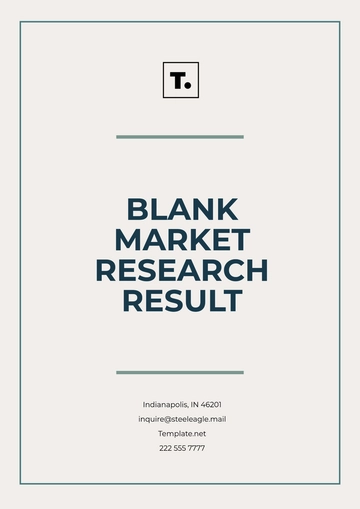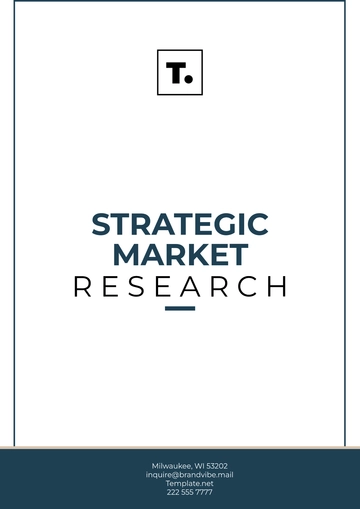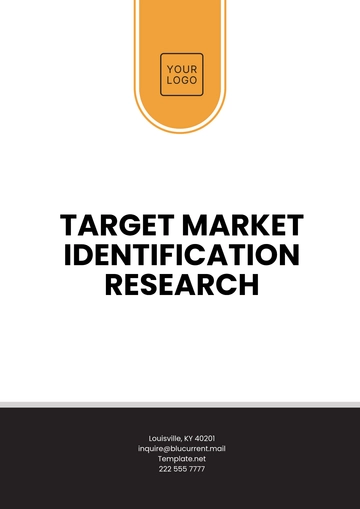Free Marketing Trending Topics Research Document

1. Executive Summary
This report outlines the central findings and recommendations of our comprehensive research on the trending topics in the marketing landscape that bear significant relevance to [Company Name]'s ongoing and future business strategies. This report centers on three main pillars: social media trends, consumer behavior shifts, and advances in technology. In the realm of social media, emerging formats like video content and ephemeral stories are gaining traction, requiring a potential shift in content creation strategies. With regard to consumer behavior, our research indicates an accelerated transition towards online shopping and a growing emphasis on sustainability, factors that necessitate an adjustment in both digital and operational paradigms. Technological advancements, particularly in Artificial Intelligence and Virtual Reality, offer promising avenues for enhanced customer personalization and engagement. The objective is to arm [Company Name] with actionable insights that will not only help in better understanding the ever-evolving marketing environment but also provide a competitive edge in market positioning, customer acquisition, and retention.
2. Objectives
The objectives of this report are clearly delineated to offer [Company Name] a structured approach to understanding the current marketing trends that are vital for its growth and profitability. By offering a granular analysis, we aim to shed light on trends that are most pertinent, their implications for the company's operations, and a series of actionable recommendations designed to leverage these trends for maximum benefit.
To identify marketing trends that are relevant to [Company Name]. The rapidly evolving nature of the marketing landscape necessitates constant vigilance to stay ahead of the curve. The first objective of this report is to sieve through the plethora of information and identify trends that have specific applicability to [Company Name]'s market, products, and target audience. This involves extensive research through journals, online publications, and real-time data analytics, and aims to create a filtered list of trends that the company can consider incorporating into its marketing strategies.
To assess the potential impact of these trends on business operations. Understanding a trend is only the first step; the real value lies in evaluating its impact on the organization. Our second objective focuses on creating a nuanced understanding of how the identified trends can affect various aspects of [Company Name]'s business operations. This could range from alterations needed in the production line due to a shift towards sustainability, to changes in the online user interface to cater to the emerging trends in e-commerce. The goal is to provide a comprehensive outlook that includes both opportunities and challenges, helping the management make informed decisions.
To provide actionable recommendations for capitalizing on these trends. The final objective is the natural culmination of the preceding steps: providing actionable recommendations that [Company Name] can employ to its advantage. These recommendations will be grounded in rigorous analysis and aimed at both short-term gains and long-term sustainability. Whether it's advising an investment in Artificial Intelligence for personalized marketing or recommending partnerships with sustainable vendors, each recommendation will come with a clearly defined path for implementation, expected outcomes, and key performance indicators to measure success.
By meeting these objectives, this report aims to offer [Company Name] a strategic framework for navigating the complexities of the modern marketing environment effectively and profitably.
3. Methodology
The methodology chapter outlines the research design and the different data sources utilized to achieve the objectives of this report. A multi-pronged approach has been adopted to ensure a comprehensive, nuanced understanding of the current marketing trends affecting [Company Name]. This hybrid methodology combines qualitative and quantitative research and is intended to offer a well-rounded perspective. Below, we provide details for each of the data sources.
Online Journals and Publications. In an era marked by rapid digital transformation, staying updated with scholarly articles and expert opinion pieces is vital for a deep understanding of any subject. Online journals and publications from reputable sources serve as the foundational layer for our research. These resources provide academic rigor and a broad context within which specific trends can be understood. They also offer insights into the theoretical underpinnings of new marketing phenomena, giving us a well-rounded view of the trends relevant to [Company Name].
Social Media Analytics. The pulse of contemporary marketing trends can often be felt most strongly on social media platforms. To capture real-time data and community sentiment, we tapped into various analytics tools that monitor trends on platforms like Facebook, Instagram, and Twitter. This approach allowed us to quantify the popularity and engagement levels of various marketing strategies, thus adding empirical weight to our research. Social media analytics also provide immediate feedback on consumer preferences, which is invaluable in assessing the applicability and potential impact of these trends for [Company Name].
Consumer Surveys. To gather firsthand data from the market, consumer surveys were employed. These surveys were designed to gauge consumer opinions on various emerging trends and their purchasing behaviors. Conducted both online and offline for a diverse demographic profile, the surveys help us understand the nuances in consumer attitudes and expectations. This granular level of detail enables us to predict how well [Company Name]'s offerings align with market demands, thereby providing a more targeted set of recommendations.
Industry Reports. Industry reports provide a macro view of the marketing landscape, offering data and insights that are both broad and deep. These reports are particularly useful in understanding how [Company Name] stands in relation to its competitors and the industry at large. They often include case studies, market analyses, and future forecasts, all of which add layers of understanding that individual consumer or company-level data may not provide.
Through this multifaceted methodology, the report aims to offer [Company Name] a holistic view of the current marketing trends, grounded in rigorous academic research, empirical data, consumer insights, and broader industry context.
4. Key Findings
The Key Findings chapter is pivotal as it consolidates the data and insights gathered through our comprehensive research methodology. The trends identified here are organized under three overarching categories: Social Media Trends, Consumer Behavior, and Technology Advances. Each category contributes to a complex mosaic that defines the current marketing landscape. The findings are synthesized in a tabulated form for easy reference, encompassing the trend, its implications for [Company Name], and recommended action points to capitalize on these trends.
Key Findings Table
Category | Trend | Implications | Action Points |
Social Media Trends | Video Content | Increased engagement | Invest in video marketing |
Stories Format | Short-lived content is popular | Utilize Instagram and Facebook Stories | |
Consumer Behavior | Online Shopping | E-commerce growth | Enhance online shopping experience |
Sustainability | Growing consumer demand | Implement sustainable practices | |
Technology Advances | Artificial Intelligence | Personalization | Integrate AI in marketing strategies |
Virtual Reality | Immersive experience | Explore VR for product showcases |
The table serves as a quick reference guide but is underpinned by in-depth analysis and research, providing a comprehensive outlook for shaping [Company Name]'s marketing strategies.
5. Recommendations
The Recommendations section serves as a strategic compass for [Company Name], outlining specific courses of action to capitalize on the identified trends in marketing. These recommendations are derived from our in-depth analysis in the Key Findings chapter, ensuring that they are grounded in solid research and empirical data. We understand that implementing new strategies requires investment—both financial and in manpower—thus, these suggestions aim to offer the highest return on investment, aligned with the company's broader business goals.
Increase investment in video marketing. Our research in the area of Social Media Trends indicated a strong preference among consumers for video content, which also tends to result in higher engagement rates. Given this trend, it is highly recommended that [Company Name] ramps up its investment in video marketing. This could range from short, catchy product videos to more in-depth explainer videos that provide value to the customer. The investment isn't just financial but also creative; developing a unique video content strategy that aligns with the brand’s voice and messaging will set you apart from competitors.
Enhance online shopping platforms for a better user experience. In light of the findings regarding consumer behavior, specifically the continuing growth in e-commerce, it becomes imperative for [Company Name] to enhance its online shopping platforms. Customers today expect seamless, intuitive user experiences that make the shopping process not just convenient, but also enjoyable. This recommendation may involve overhauling the website’s UI/UX design, improving site speed, implementing a more user-friendly checkout process, and potentially integrating AI-driven chatbots for real-time customer service.
Adopt sustainable practices to attract a wider consumer base. The growing consumer demand for sustainability cannot be ignored. Adopting eco-friendly practices is no longer just ethically responsible but also a strong business strategy. [Company Name] should consider implementing sustainable practices throughout its operation, whether it's sourcing materials responsibly, reducing waste, or utilizing energy-efficient methods. This not only broadens your appeal to a consumer base that increasingly values sustainability but also potentially reduces long-term operating costs.
Each of these recommendations is aimed at offering [Company Name] a multi-faceted approach to leverage the identified trends, enhance customer engagement, and ultimately, bolster profitability.
6. Conclusion
In a marketing landscape that is constantly evolving, staying abreast of the latest trends and swiftly implementing changes is not just beneficial—it's crucial for the long-term viability and success of [Company Name]. This report has laid out key trends in Social Media, Consumer Behavior, and Technological Advances that are not mere ephemeral shifts but seem poised to shape the industry in the foreseeable future. By understanding these trends and adopting the corresponding recommendations, [Company Name] has the opportunity to gain a significant competitive edge. Immediate action on these insights is not just recommended, but imperative, given the fast-paced nature of market changes. The proposed recommendations offer a strategic roadmap for both short-term gains and long-term sustainability, and the time to act is now to ensure that [Company Name] remains a relevant, compelling player in its market.
7. Appendices
Appendix A: Full Social Media Analytics Report
This appendix provides a comprehensive social media analytics report that offers an in-depth look at the data supporting the Social Media Trends discussed in the main report. It includes various metrics such as engagement rates, follower counts, and content performance for platforms like Facebook, Instagram, and Twitter.
Metrics | |||
Engagement Rates | 5.2% | 7.8% | 3.1% |
Top Performing Posts | Product Launch Announcement (12k Likes, 200 Shares) | Behind-the-Scenes Content (15k Likes, 500 Comments) | Customer Testimonial (1.2k Retweets, 2k Likes) |
Demographics Metrics | Details |
Average Age | 28-34 |
Gender Split | 45% Male, 55% Female |
Top Locations | New York, San Francisco, London |
Appendix B: Consumer Survey Data
In Appendix B, we provide the complete dataset collected from the consumer surveys. These surveys aimed to gauge consumer opinions on various emerging trends and their purchasing behaviors. This data is invaluable for understanding consumer preferences.
Appendix C: Technology Advances Details
Appendix C offers detailed insights into the advancements in technology that are shaping the marketing landscape. It provides comprehensive descriptions, use-cases, and potential impacts of technologies such as Artificial Intelligence and Virtual Reality.
Technology Advances Details Table
Technology | Description | Use-Cases | Impact |
Artificial Intelligence | Artificial Intelligence refers to the simulation of human intelligence processes by machines, especially computer systems. | Chatbots for customer service, predictive analytics for sales forecasting, personalized marketing strategies. | Can significantly improve customer engagement and operational efficiency. |
Virtual Reality | Virtual Reality is a simulated experience that can be similar to or completely different from the real world. | Virtual product showcases, immersive brand experiences, training simulations. | Offers a unique, engaging customer experience, setting the brand apart in a crowded marketplace. |
_____________________________________________________________________________________
For further information, please contact [Your Name, Your Contact Details].
- 100% Customizable, free editor
- Access 1 Million+ Templates, photo’s & graphics
- Download or share as a template
- Click and replace photos, graphics, text, backgrounds
- Resize, crop, AI write & more
- Access advanced editor
Explore the Marketing Trending Topics Research Document Template on Template.net! This editable and customizable tool empowers you to delve into current industry trends. Seamlessly adapt it to suit your research needs using our AI Editor Tool. Stay ahead of the curve and harness the power of trending topics for your marketing strategy!





























